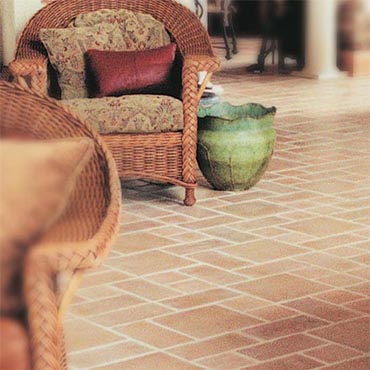Seneca Tiles Inc., manufacturerand importer of distinctive ceramic tiles, invites you to experience our exciting collection of ceramic tile, available exclusively through leading distributors in North America Learn More
Terra Cotta Floor Tile
Terra Cotta Floor Tile Guide

Terra Cotta Floor Tiles: Time-Honored Tradition Meets Modern Mastery
Introduction:
Terra Cotta floor tiles have journeyed through centuries, evolving from ancient artifacts to modern marvels in the realms of architecture and interior design. Originating from the Latin "terra cocta," meaning "baked earth," these tiles have adorned the floors of palaces, temples, and homes, transcending time to become a staple in contemporary design. This article delves into the historical significance and the remarkable evolution of Terra Cotta in modern architecture and interior design, highlighting its unparalleled blend of durability, aesthetics, and sustainability.
Defining Terra Cotta in Floor Tile Context:
Terra Cotta, a type of earthenware, is a clay-based ceramic, where the fired body is porous. In floor tiles, Terra Cotta offers a rustic, yet elegant charm, marked by its natural earthy tones and distinctive texture. This ancient material, once the prerogative of emperors and kings, is now a versatile choice for architects and designers.
Material Properties and Sustainability:
Terra Cotta tiles are celebrated for their durability and resistance to wear and tear, attributes essential in high-traffic areas. Their low maintenance requirements, coupled with a lifespan that often surpasses that of their owners, make them an enduring choice. The eco-friendly nature of Terra Cotta is underscored by energy-efficient production processes and recyclability, aligning with contemporary green building practices.
Design Versatility and Aesthetics:
The design potential of Terra Cotta tiles is virtually limitless. Available in a plethora of colors, patterns, sizes, and finishes, these tiles offer designers the freedom to create bespoke environments. Whether aiming for a traditional look or a modern aesthetic, Terra Cotta tiles provide solutions that enhance various architectural styles.
Technical Advancements:
Technological innovations in the manufacturing of Terra Cotta floor tiles have expanded their applicability. Advanced firing techniques and glazing options have not only improved their durability but also opened up new avenues for custom designs and finishes, pushing the boundaries of creativity in architectural spaces.
Application Diversity:
Terra Cotta's versatility extends to its wide-ranging applications. From rustic kitchens to elegant hotel lobbies, these tiles have been employed to create atmospheres that are both inviting and functional. Innovative use in projects, ranging from contemporary homes to historic renovations, showcases the adaptability of Terra Cotta in various architectural contexts.
Performance and Functionality:
Beyond aesthetics, Terra Cotta tiles offer practical advantages. Their natural composition makes them water-resistant and hypoallergenic, fostering hygienic environments. This makes them particularly suitable for healthcare facilities and commercial spaces. Furthermore, their ability to withstand heavy foot traffic without losing their allure makes them a practical choice for both residential and public spaces.
Sustainability and Environmental Impact:
Terra Cotta tiles contribute significantly to sustainable building practices. They are often used in projects aiming for LEED certification due to their natural composition and energy-efficient production. The environmental and health impacts of Terra Cotta tiles are minimal, making them a responsible choice in the age of environmentally conscious building specifications.
Cultural and Artistic Significance:
Terra Cotta floor tiles hold profound cultural significance across various regions. Contemporary designers leverage this rich heritage, blending traditional designs with modern techniques, thereby creating spaces that are both culturally rich and aesthetically modern.
Cost-Effectiveness and Long-Term Value:
The long-term value of Terra Cotta tiles, in terms of durability and timeless appeal, often outweighs their initial cost. When compared with other flooring materials, Terra Cotta tiles emerge as a cost-effective solution, especially in scenarios demanding longevity and aesthetic versatility.
Conclusion:
Terra Cotta floor tiles are more than just a design element; they are a testament to the enduring relationship between art, nature, and architecture. As we step into the future, the role of Terra Cotta in shaping architectural and design trends is undeniable. Architects, interior designers, and facility managers are encouraged to explore the innovative potential of Terra Cotta floor tiles, ensuring their projects not only resonate with the present but also echo through the annals of time.
Disclaimer: The information provided in this article is for general informational purposes only. While we strive to ensure the accuracy and reliability of the information presented, we make no warranties, express or implied, about the completeness, accuracy, reliability, suitability, or availability with respect to the content. Any reliance you place on such information is strictly at your own risk. We recommend consulting with professionals for specific advice tailored to your project’s needs, particularly regarding building codes, regulations, and product specifications.
Under no circumstances shall we be liable for any loss or damage, including without limitation, indirect or consequential loss or damage, arising from the use of, or reliance on, the information provided in this article.
Select Product Sub-Category:
Terra Cotta Floor Tile
Top 1 Types of Terra Cotta Floor Tile
 Ceramic/Porcelain - 403 Mexican Tile (Saltillo)Introducing authentic Mexican Tile (Saltillo) – a blend of artistry and craftsmanship. Elevate your space with these handcrafted tiles that bring a touch of Mexico's rich heritage to your home. Transform your surroundings today! |
Featured Brands
Terra Cotta Floor Tile News
Latest Terra Cotta Floor Tile News
Terra Cotta Floor Tile...Terra Cotta Floor Tile: A Timeless Choice for Modern Design Terra Cotta, an enduring material in the realm of floor tiles, has seamlessly transitioned from its historical roots to a staple in contemporary home decor and interior design. Its journey from ancient building material to a cherished element in modern homes is a testament to its timeless appeal. Historical... |

